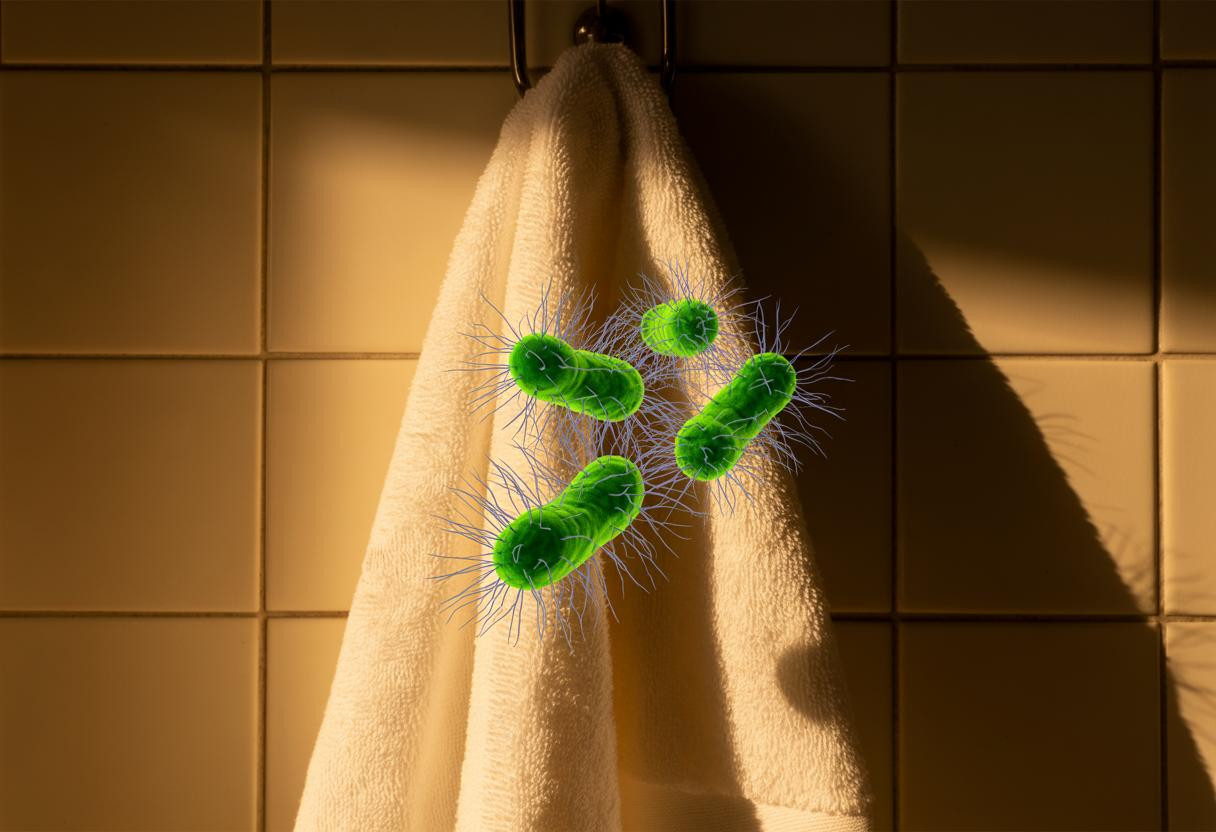That innocent face towel hanging in your bathroom could be silently sabotaging your skin health in ways that won’t show up for weeks or even months. While you might feel fresh and clean after each use, reused face towels create an invisible breeding ground for acne-causing bacteria that transfers directly to your skin without triggering immediate warning signs.
Unlike body towels that dry larger surface areas, face towels remain damp longer and come into direct contact with your most sensitive facial skin. This creates the perfect storm for bacterial colonization that operates below your awareness threshold.
The hidden microbial transfer happening on your skin
Every time you press that seemingly clean towel against your face, you’re potentially introducing Pseudomonas aeruginosa and Staphylococcus aureus – two bacteria strains that thrive in the warm, moist environment of reused fabric. Research shows these microbes can survive on cotton towels for up to 21 days, multiplying silently while you remain completely unaware.
The transfer mechanism works through what scientists call the “pummeling effect” – the gentle pressure and friction of towel-to-skin contact dislodges accumulated bacteria and deposits them directly into your pores. Unlike visible infections that announce themselves immediately, this process creates subclinical disruption of your skin’s natural microbiome that builds over time.
What makes this particularly insidious is that your skin’s barrier function becomes compromised gradually. The repeated bacterial deposits trigger low-level inflammation through your immune system’s Toll-like receptors, creating the perfect conditions for future breakouts without any current symptoms.
Why your skin doesn’t sound the alarm immediately
Your facial skin operates on a delayed reaction system when it comes to bacterial contamination. Just as whitening toothpaste habits that destroy enamel work gradually before showing visible damage, towel-related bacterial transfer creates cumulative effects that manifest weeks later as unexplained breakouts.
The absence of immediate symptoms occurs because surface bacteria don’t directly cause acne – they need time to penetrate deeper into follicles and trigger inflammatory responses. During this silent incubation period, harmful microbes are establishing colonies and disrupting your skin’s natural defense mechanisms.
The deceptive comfort zone
Many people develop a false sense of security because their towel looks and smells clean. However, bacteria colonies can thrive invisibly, especially in humid bathroom environments where towels never fully dry between uses. Moisture levels above 70% create optimal breeding conditions that support microbial growth for extended periods.
Smart solutions that protect without paranoia
The solution doesn’t require expensive products or extreme measures. Microfiber face towels washed weekly in water heated to at least 140°F eliminate 99% of bacterial contamination while remaining cost-effective and environmentally sustainable.
Consider the antimicrobial textile approach – towels infused with silver or copper ions that naturally inhibit bacterial growth between washes. While initially more expensive, these materials provide continuous protection that reduces the frequency of required washing cycles.
The separate towel strategy
Designating specific towels exclusively for your face prevents cross-contamination from body bacteria and soap residues. This simple separation reduces your exposure risk by approximately 60% compared to shared-use towels, according to dermatological studies.
Quick-drying materials like bamboo-cotton blends offer another layer of protection by minimizing the moisture retention that bacteria require for proliferation. Unlike traditional cotton, these fabrics reduce bacterial survival rates significantly.
Breaking the invisible cycle of contamination
The psychology behind towel reuse often stems from convenience rather than conscious risk assessment. Similar to how psychological barriers to lifestyle changes prevent people from addressing obvious problems, many individuals resist changing towel habits despite understanding the risks.
Social media has amplified awareness, with skincare influencers promoting disposable alternatives. However, these trends sometimes create unnecessary anxiety about normal hygiene practices. The key lies in finding sustainable solutions that balance protection with practicality.
Your skin’s future depends on today’s choices
The bacteria transferring to your skin today will influence your complexion in the weeks ahead. By implementing simple towel hygiene protocols now, you’re investing in clearer, healthier skin that won’t surprise you with mysterious breakouts later. Prevention remains infinitely easier than treatment when it comes to bacterial-induced skin issues.
